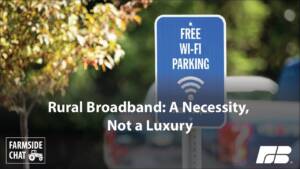
Rural Broadband

Issue Overview
Rural broadband is essential to modern agriculture, the farmers and ranchers who grow our food and the quality of life for rural Americans. Farm Bureau supports using the Universal Service Fund to expand broadband deployment to rural areas. We also support using a combination of tax incentives, grants and/or regulation to increase the use of broadband access in rural areas.
Broadband access is essential for farmers and ranchers to follow commodity markets, communicate with customers, and access new markets around the world.
Impact
Precision Agriculture
Farmers and ranchers depend on broadband just as they do highways, railways and waterways to ship food, fuel and fiber across the country and around the world. Many of the latest yield maximizing farming techniques require broadband connections for data collection and analysis performed both on the farm and in remote data centers. However, 18 percent of U.S. farms have no access to the Internet according the USDA report, “Farm Computer Usage and Ownership, 2021.”
America’s farmers and ranchers embrace technology that allows their farming businesses to be more efficient, economical and environmentally friendly. Today’s farmers and ranchers are using precision agricultural techniques to make decisions that impact the amount of fertilizer a farmer needs to purchase and apply to the field, the amount of water needed to sustain the crop, and the amount and type of herbicides or pesticides the farmer may need to apply. These are only a few examples of the ways farmers use broadband connectivity to achieve optimal yield, lower environmental impact and maximize profits.
Farmers and ranchers rely on broadband access to manage and operate successful businesses, the same as small businesses do in urban and suburban America. Access to broadband is essential for farmers and ranchers to follow commodity markets, communicate with their customers, gain access to new markets around the world and, increasingly, for regulatory compliance.
Quality of Life
Rural communities need access to health care, government services, and educational and business opportunities. For many rural communities, access can only be gained by using broadband services and sophisticated technologies that require high-speed connections. According to the Federal Communications Commission, 17 percent of rural Americans lack access to 25 Mbps/3 Mbps service, compared to only 1 percent of urban Americans. Current and future generations of rural Americans will be left behind their fellow citizens if they are without affordable high-speed broadband service that enables them to tap into health care and educational services, government agencies, and new business opportunities.
Background
Federal programming for broadband deployment primarily occurs under the jurisdiction of the FCC, the Rural Utilities Service (RUS) of the United States Department of Agriculture, and the National Telecommunications and Information Administration (NTIA) of the Department of Commerce. The FCC regulates interstate and international communications by radio, television, wire, satellite, and cable across the country. It implements and enforces America’s communications laws and regulations. Its broadband programs focus on broadband infrastructure, digital inclusion and adoption.
The RUS focuses on rural communities and provides loans and grants for infrastructure and infrastructure improvements for telecommunications services. The NTIA is the Executive Branch agency that is principally responsible for advising the President on telecommunications and information policy issues.
In 2021, Congress adopted the bipartisan Infrastructure Investment and Jobs Act (IIJA), legislation supported by Farm Bureau, which included a $65 billion investment in broadband. The majority of this investment is administered by the NTIA which is currently implementing new programs authorized under the law including the Broadband Equity, Access and Deployment (BEAD) Program.
WHAT WE'RE SAYING



